#Ecce homo
Text
Among the many downsides of AI-generated art: it's bad at revising. You know, the biggest part of the process when working on commissioned art.
Original "deer in a grocery store" request from chatgpt (which calls on dalle3 for image generation):

revision 5 (trying to give the fawn spots, trying to fix the shadows that were making it appear to hover):

I had it restore its own Jesus fresco.
Original:

Erased the face, asked it to restore the image to as good as when it was first painted:
Wait tumblr makes the image really low-res, let me zoom in on Jesus's face.
Original:
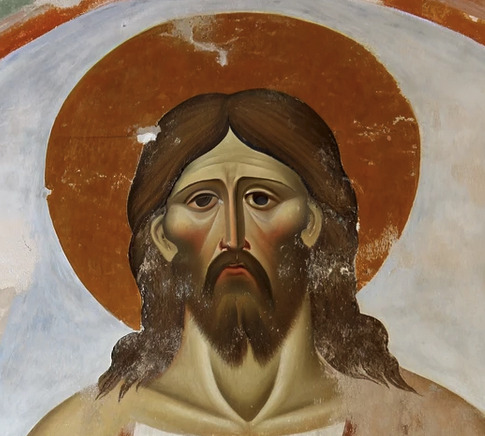
Restored:

One revision later:
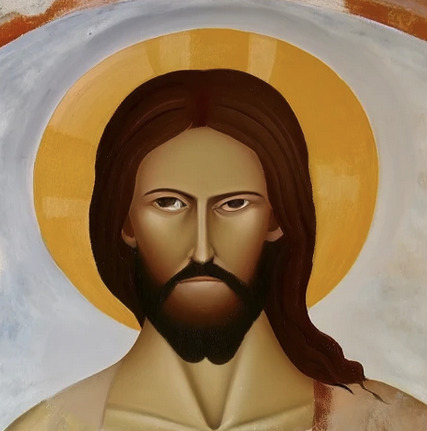
Here's the full "restored" face in context:

Every time AI is asked to revise an image, it either wipes it and starts over or makes it more and more of a disaster. People who work with AI-generated imagery have to adapt their creative vision to what comes out of the system - or go in with a mentality that anything that fits the brief is good enough.
I'm not surprised that there are some places looking for cheap filler images that don't mind the problems with AI-generated imagery. But for everyone else I think it's quickly becoming clear that you need a real artist, not a knockoff.
more
#ai generated#chatgpt#dalle3#revision#apart from the ethical and environmental issues#also: not good at making art to order!#ecce homo
3K notes
·
View notes
Text

Ecce Homo (1575-1642, oil on panel) | Guido Reni
395 notes
·
View notes
Text

Il Sodoma - Ecce Homo. 1510
158 notes
·
View notes
Text

Vicente Juan Masip (Spanish, 1507-1579)
Ecce Homo, ca.1570
Ecce homo (English: behold the man) are the Latin words used by Pontius Pilate in the Vulgate translation of the Gospel of John, when he presents a scourged Jesus, bound and crowned with thorns, to a hostile crowd shortly before His crucifixion.
#ecce homo#behold the man#catholic art#christian art#christian#catholic#christianity#christentum#catholicism#roman catholic#spanish art#spanish#spain#juan de juanes#Vicente Juan Masip#1500s#hispanic#latin#western civilization#medieval
98 notes
·
View notes
Text




jhona burjack photographed by lorenzo fanfani for ecce homo
197 notes
·
View notes
Photo
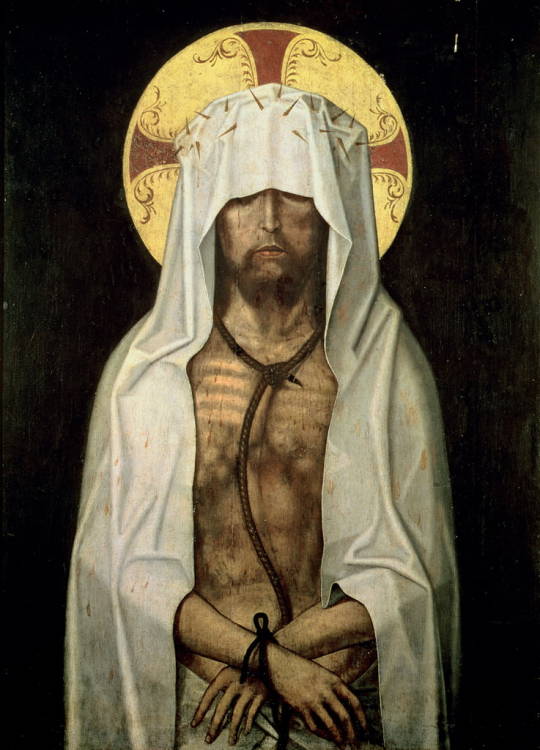
Ecce Homo (Tempera auf Tafel)
Tempera auf Holz, Museu Nacional de Arte Antiga, Lisbon, Portugal
#Portuguese School#christentum#religion#glaube#kunst#gemälde#meisterwerk#kunstdruck#museum#galerie#kunstwerk#kirche#portugal#portuguese#ecce homo#dark#faith#church
333 notes
·
View notes
Text

Ota Janeček (1919-1996) — Ecce Homo [oil on canvas, 1983]
62 notes
·
View notes
Text

Rembrandt
#rembrant van rijn#rembrandt#christ#ecce homo#art#artwork#fine art#fineart#painting#art history#history of art
31 notes
·
View notes
Text
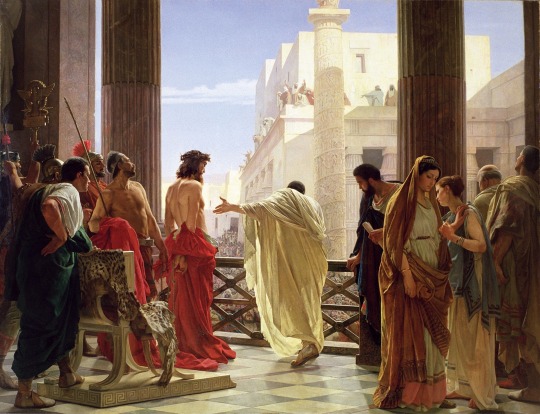
Ecce Homo ("Behold the Man") by Antonio Ciseri
#ecce homo#art#religious art#antonio ciseri#pontius pilate#jesus christ#jerusalem#roman#romans#judaea#history#religion#christianity#christian#roman empire#jesus#christ#hostile#crowd#crown of thorns#pilate#architecture#gospel#ancient rome
364 notes
·
View notes
Text
The Suffering God
In all religions, a question mark has been set against the omnipotent and serene gods by the sufferings of men. But only in Christ does the concept of a suffering God appear. […] Only in Christ does it become clear that we can put God to death because he has put himself in our hands. Only since Christ has God become dependent on us. Christ did not identify himself with a calm spectator of all our troubles. Christ, by his teaching, life, and death, made plain the helplessness of God in the world; the suffering of unrequited and unsuccessful love.
[...]
That God in the world has been, and still is, mocked and tortured, burnt and gassed: that is the rock of the Christian faith which rests all its hope on God attaining his identity. This pain is inextinguishable; this hope can never be taken away. What Christians share in common is 'their participation in the sufferings of God in Christ. That is their faith.' In this faith they know that God is helpless and needs help. […] He put himself at risk, made himself dependent on us, identified himself with the non-identical. From now on, it is high time for us to do something for him.
- Dorothee Soelle (Christ the Representative: An Essay in Theology After the 'Death of God,' pages 151, 151-152). Bolded emphases added.

Man of Sorrows, by Theophilia
#Christianity#theodicy#Jesus Christ#Incarnation#vulnerability#compassion#suffering#Sacred Heart#Ecce Homo#Divine Mercy of Jesus#Dorothee Soelle
32 notes
·
View notes
Text

Alvise Donati (1450 - 1534) - Ecce Homo. Detail.
338 notes
·
View notes
Text
All night you pace between our bed and another
room in the house, fetching glasses of water
when you mean shots of gin. The candle
doesn’t catch your naked body—a leg, the cut
of stubble—but the shadow of its leaving,
the whole of you uncontainable like the moon,
its kissable face and its darker chambers.
Mary offers her mangled son like a matchmaker,
from the dollar-store votive by the bed.
(Other nights John the Baptist rolls his eyes at me.)
You’re the one who stayed, or
at least never left. You stay because of hard rain,
or dead magnolia on the drive; or is it custom
for the wounded to care for the wounded?
Where are you? I need a solitary room
with you in it. Wall me in. Lie down on me.
- Derrick Austin, Devotions.
22 notes
·
View notes
Text

Mateo Cerezo (The Younger) (Spanish, 1637-1666)
Ecce Homo, ca.1660-66
Museum of Fine Arts, Budapest
Ecce homo (English: behold the man) are the Latin words used by Pontius Pilate in the Vulgate translation of the Gospel of John, when he presents a scourged Jesus, bound and crowned with thorns, to a hostile crowd shortly before His crucifixion.
#Mateo Cerezo#the younger#spanish art#spanish#spain#ecce homo#1600s#art#fine art#european art#classical art#europe#european#fine arts#oil painting#europa#mediterranean#christian art#christian#christianity#christentum#catholic#catholic art#catholicism#hispanic#latin#painting#Jesus Christ#Son of God#God the Son
96 notes
·
View notes
Text
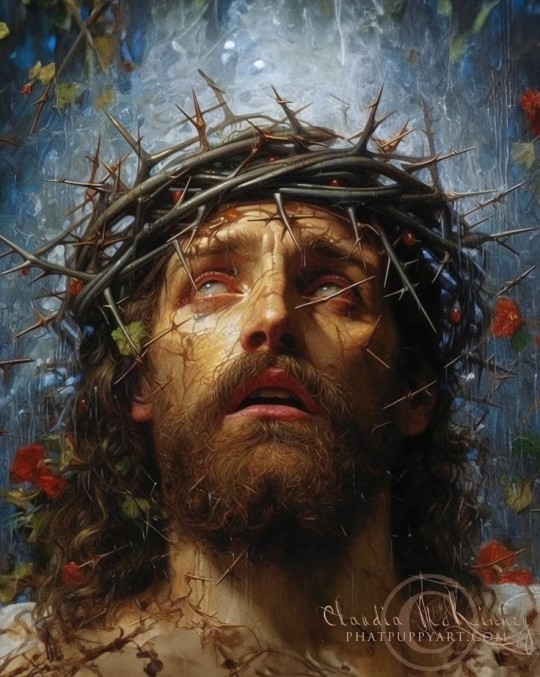
#catholic#catholicism#christianity#spiritual warfare#jesus christ#blessed virgin mary#our lady#exorcist#demon#ecce homo#crown of thorns#our lord and savior#our lord#lord have mercy#lord jesus christ#christ the king#orthodox christianity#christian faith#christ#jesus#jesuscristo#viva cristo rey#passion of the christ
17 notes
·
View notes
Text

'Ecce Homo' (Unfinished Pare Lorentz Film), 1939, view from the 18th St. Bridge
48 notes
·
View notes
